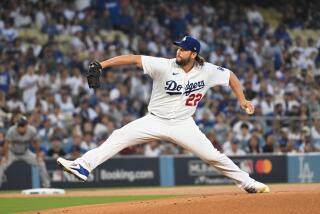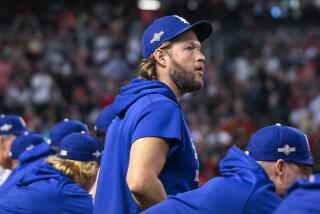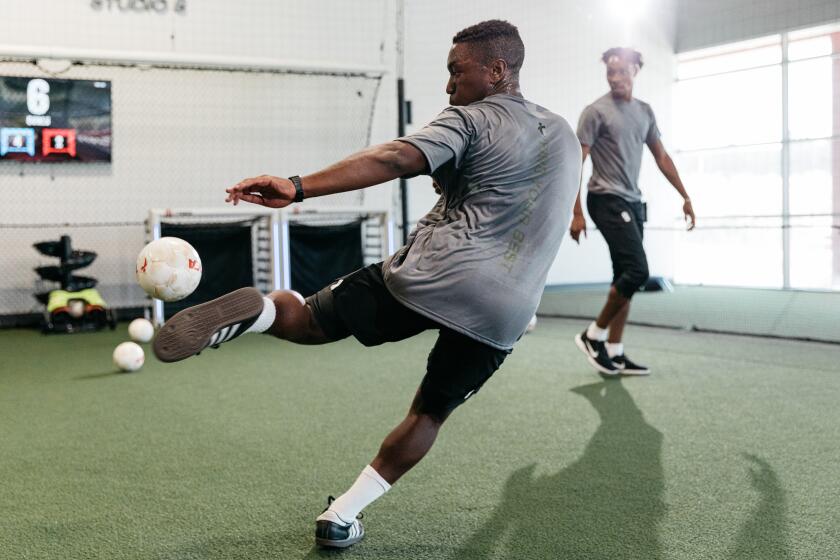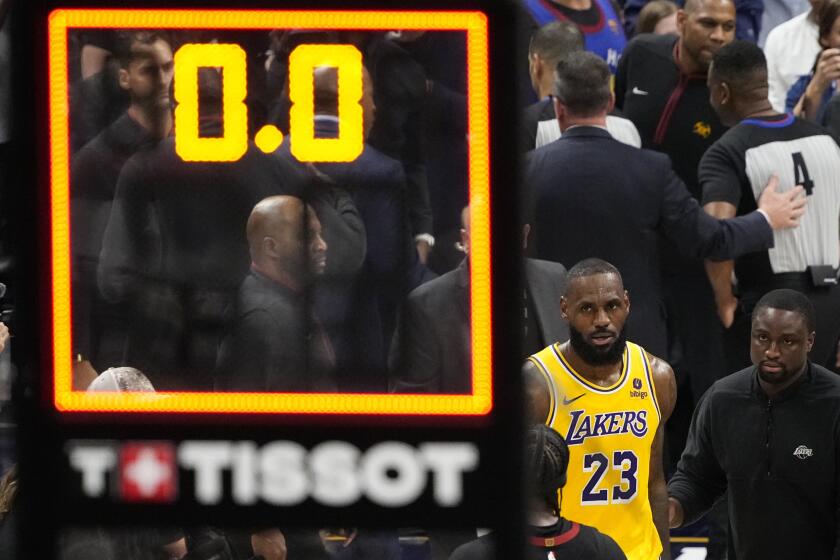Dodgers pitcher Clayton Kershaw wins on grit, not power
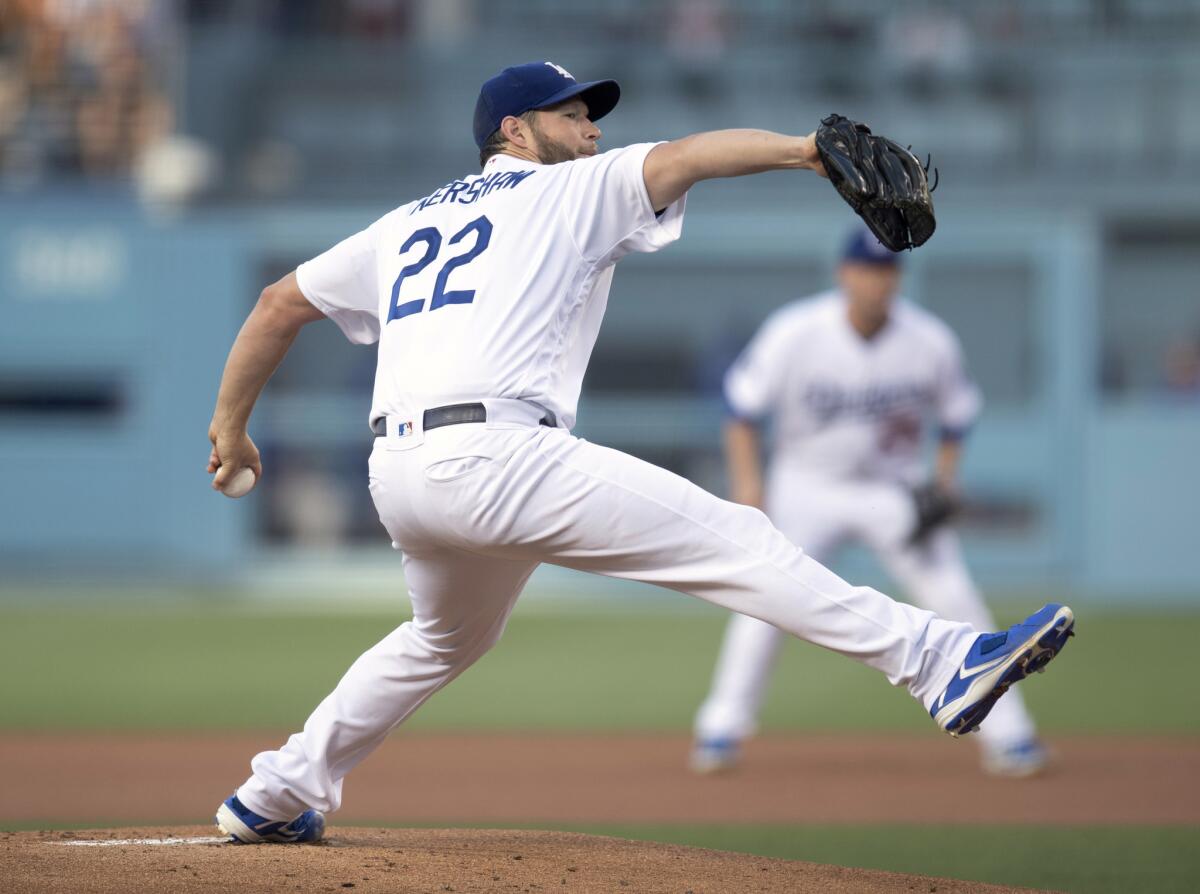
The list of aces flowed forth from Clayton Kershaw. He ticked off the names of his 30-something peers, all older than him, all still thriving: Max Scherzer. Justin Verlander. Zack Greinke. The implication felt clear.
“They’re still going strong,” Kershaw said with a small smile after collecting the win in a 7-3 Dodgers victory over the Chicago Cubs. “There’s hope.”
In his 12th season, at the age of 31, Kershaw (6-1, 3.13 ERA) has embraced the art of self-deprecation. He still prefers not to waver on the mound. But he has accepted the limitations on his body while making the adjustments required to remain effective. His outing in the Dodgers’ series opener Thursday against the Cubs at Dodger Stadium demonstrated both the vulnerability of his arsenal and the steeliness of his mettle — a six-inning demonstration of his new normal.
Kershaw absorbed a stunning opening salvo from Chicago’s lineup. He outlasted and outpitched Jon Lester, the rugged 35-year-old left-hander who still anchors Chicago’s rotation. While Lester sank in the middle innings, Kershaw steadied himself to limit the Cubs to three runs. He matched his season high with eight strikeouts.
“It was a little bit of a grind,” manager Dave Roberts said. “I appreciate the way he tried to continue to find that curveball, but just couldn’t really get the feel for it tonight. But like he seems to do, many times over, it’s just make pitches when he needs to.”
When the evening began, Kershaw climbed onto the mound with his earned-run average for the season at an even 3.00. He has not completed a season with an ERA that inflated since his rookie campaign in 2008. Even so, his mark left him tied with Cubs starter Kyle Hendricks for the 19th-lowest ERA in the game heading into Thursday.
In his previous two outings, Kershaw had logged 14 innings and given up three runs against the Philadelphia Phillies and the San Francisco Giants. The Cubs presented a more daunting challenge than the previous two opponents, as Roberts outlined before the game. To Roberts, the Cubs looked like a mirror of his own team. “They can slug,” Roberts said. “They’re athletic. They’re dynamic.”
Kershaw saw all three elements in the first inning. His first pitch of the evening was a 90-mph fastball. Cubs outfielder Kyle Schwarber shipped the baseball over the center-field fence. It was the ninth homer given up by Kershaw in 11 starts this season.
Kershaw compounded the trouble by walking outfielder Kris Bryant with fastballs and sliders that missed low and away. Bryant jetted from first to third on a double by first baseman Anthony Rizzo, who turned on a 91-mph fastball. A flare by catcher Willson Contreras added a run to Kershaw’s ledger. The inning ended only when catcher Austin Barnes deked Rizzo off third base and into a rundown.
“That was helpful,” Kershaw said. “No doubt.”
With the rally snuffed, Kershaw brushed off the shaky start. No longer does he overwhelm opponents. He muffles them, subdues them, thwarts their plans by avoiding their barrels. In the opposing dugout, the left-handed starting pitcher served as a paragon for the value of these skills.
Lester has never reached the individual heights Kershaw has summited. He has never won a Cy Young Award, never received a vote for most valuable player. But he’s helped win three World Series championships, carved out an unimpeachable place in the history of both the Cubs and the Boston Red Sox, and has demonstrated how to remain viable when velocity fades.
Since 2016, Lester’s fastball has decelerated from 92 mph to 90. His performance has remained relatively static. He challenges hitters inside the strike zone and then coaxes them to venture outside of it. He has increased his usage of a cutter. He wields a changeup, a pitch Kershaw has never mastered.
The usefulness of a changeup applies to Kershaw’s encounters with right-handed hitters. A changeup might disarm them, at a time when his fastball no longer worries them. In the first at-bat of the third inning, Kershaw elevated a 91-mph fastball on the outer half of the plate. Bryant displayed enough strength to deliver an opposite-field homer.
Sign up for our daily sports newsletter »
The steely demeanor and postseason reputation of Lester could not protect him from the fury of the Dodgers lineup on Thursday. Lester gave up three two-run homers, two in the fourth inning and an another in the fifth, to hand Kershaw the lead. He protected it with care. “Thankfully, we got the lead there,” Kershaw said. “And then you just do everything you can to not let it go.”
In the fifth, Kershaw ducked any damage despite yielding two singles. He jammed Bryant with a first-pitch fastball for one out. Rizzo popped up on a two-strike curveball. Kershaw stranded the runners when Contreras thudded a curve into the ground.
There was less contact in the sixth. Kershaw fanned second baseman Addison Russell with a curveball for his seventh strikeout. An eighth came moments later, to complete the frame, when Daniel Descalso hit in Lester’s place. Kershaw unspooled a curve that dove toward the tops of Descalso’s shoes. He still waved at the pitch.
Kershaw descended the steps into his dugout, where handshakes awaited. He had thrown 93 pitches. He would throw no more. He has not logged more than 101 pitches in a game this season; his next appearance in the eighth inning will be his first.
Yet he did not debate Roberts. He accepted the plaudits from his teammates. He would chastise himself later for walking Bryant in the first inning. Otherwise, he could accept his outing.
“Thankfully, kept them at three,” Kershaw said. “And our team did a great job of fighting back, and scoring a bunch of runs.”
Twitter: @McCulloughTimes
More to Read
Get our high school sports newsletter
Prep Rally is devoted to the SoCal high school sports experience, bringing you scores, stories and a behind-the-scenes look at what makes prep sports so popular.
You may occasionally receive promotional content from the Los Angeles Times.

